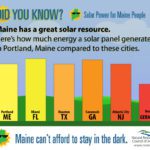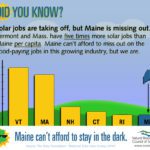Maine Solar Energy
Solar power is a clean, pollution-free, renewable energy source that is available statewide. Maine has tremendous potential for solar power, but in the past decade we have fallen behind while other states in the region (and places around the world) have enjoyed the environmental and economic benefits of solar. Now, Maine is poised to move out of last place with a suite of policies to increase solar for Maine residents, businesses, and municipalities.
5 Ways Solar Energy can Provide Environmental and Economic Benefits for Maine:
- It’s clean and renewable. Increasing the amount of clean, renewable energy we use offsets our need for fossil fuels that pollute our air and harm our health. Maine people overwhelmingly support solar energy because it reduces pollution and protects the environment. Fossil fuel-burning power plants are a leading source of climate-changing pollution. It is important that we increase renewable energy sources since climate change threatens Maine’s economy and way of life in serious ways.
- It’s affordable. Mainers are concerned about the cost of energy. Fortunately the cost of solar has plummeted in recent years to become highly competitive. From the largest-scale projects that power our entire electrical grid to the smaller projects that power a home, solar is part of the solution to lowering costs. Maine exports an average of five billion dollars a year on fossil fuels. Solar means more money that stays in our local economy.
- Solar increases energy independence. More solar means more locally produced energy and fewer dollars exported out of state for fossil fuels. Solar panels last 25-40 years and provide a predictable, secure source of power.
- Solar creates local jobs. Solar jobs are growing across the country and the region. Maine is in last place in New England for solar jobs per capita, but legislation passed in 2019 will create hundreds of good local jobs in many fields and at many different skill levels.
- Solar is good for our electrical grid and for everybody who pays an electricity bill. More locally produced energy means we all spend less on transmission lines that deliver power from far away. We also spend less to operate the most expensive power plants to meet maximum demand. Increasing the amount of solar delivered locally can save everybody money.
Where We’ve Been
In 2017, Maine’s Public Utilities Commission (PUC) adopted rule changes that gut net metering and cost all electricity customers in Maine millions of dollars in implementation expenses. The PUC’s rules set Maine’s solar progress back because, as of March 2018, utility companies began charging Mainers who installed solar a fee for the electricity they make with their own solar panels and use in their own homes and businesses. Instead of adopting modern policies to encourage solar, Maine was moving backward just as this technology was becoming mainstream. Learn about the PUC’s anti-solar proposal. In 2019 (after years of roadblocks by Governor LePage and his allies), the Legislature passed emergency legislation to reinstate net metering and repeal the rule changes.
Where We’re Going
After backward rules and years of inaction on solar, in 2019, the Maine Legislature and Governor Janet Mills also acted to accelerate solar jobs and increase the amount of solar for Maine residents, businesses, and towns. Several pieces of legislation were enacted with leadership from Republicans and Democrats. Solar legislation received broad support in both the Senate and the House of Representatives because Mainers of all political affiliations, and from all parts of the state, spoke up in favor of solar over many years.
Maine Solar Projects
At the start of 2019, Maine had 55 megawatts (MW) of installed solar. In the next five years that is expected to increase to more than 500 MW, with a number of different types of projects. Wondering what that looks like?
(Remember that one megawatt equals 1,000 kilowatts (KW).)
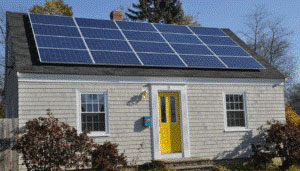
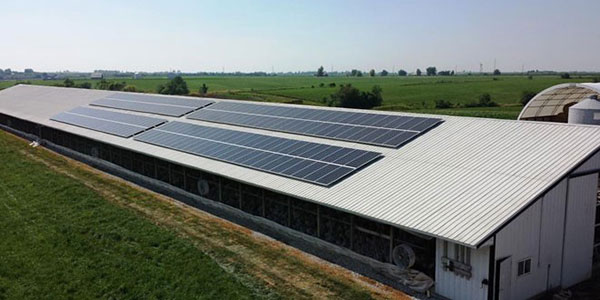
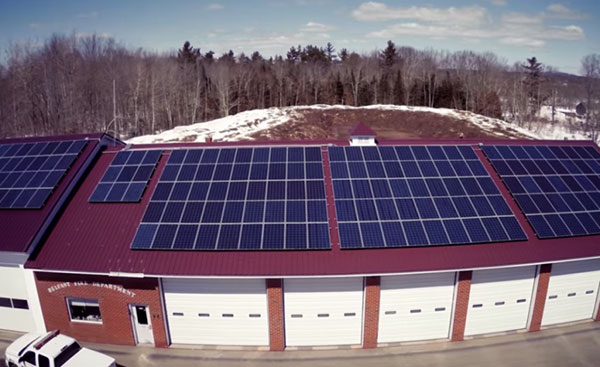
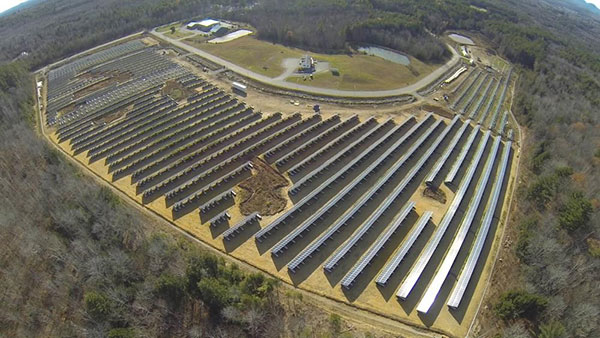
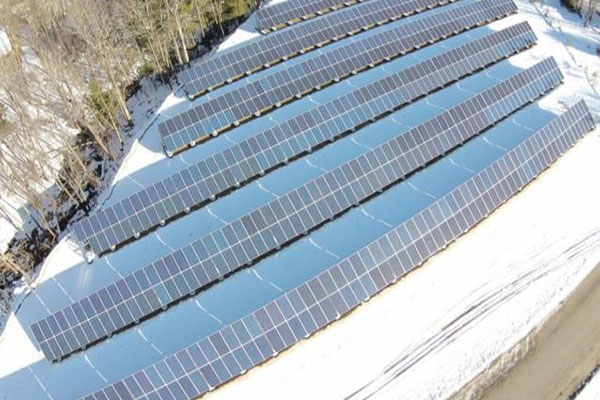
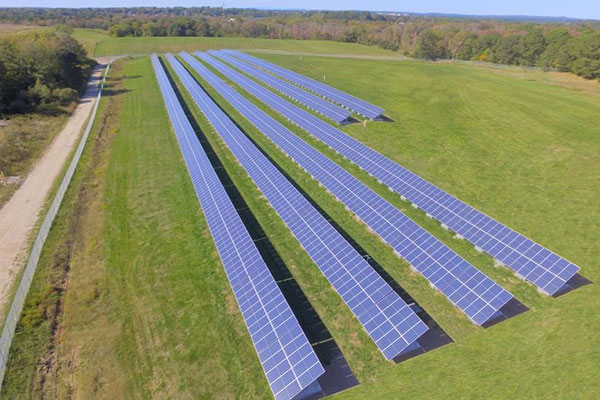
There are many different types of projects in addition to the familiar home rooftop system:
Community Solar: Ownership Shares or Subscriptions
In 2019, Maine became the 21st state in the country to pass community solar legislation that increases access to solar for everybody, regardless of the type of home they live in.
Community solar is a group solar project where subscribers get the benefits of solar without the upfront costs and shareholder owners can reduce costs through economies of scale. Anyone who pays an electric bill (businesses, municipalities, homeowners) can be a part of a community solar project to start using cleaner, cheaper energy.
This video helps explain how it works:
With the passage of LD 1711, Maine will initiate a competitive process and developers will work with communities and landowners to build 250 MW of community solar (each project up to 5 MW). There will be incentives to build these projects on previously impacted land, like landfills or rooftops. NRCM and others in the conservation community are working together and with developers and to encourage responsible siting of these projects.
Municipal Solar Projects
Towns across Maine like Belfast, Lincolnville, and many others have already invested in solar to save money, gain predictable and stable energy costs, and reduce their dependence on fossil fuels.
The passage of LD 1711 removes barriers so more towns in Maine can go solar. Whether through a single municipal electrical account or multiple, this bill allows municipalities to subscribe to projects that are as large as 5 MW in their same utility territory, for example CMP or Emera territory, and receive credits on electric bills.
Commercial Customers
Businesses can subscribe to community solar, but for some commercial or institutional customers, an individual solar project might better meet their energy or financial needs. For example, by giving them complete control over siting and enabling them to make their own financing arrangements.
In addition to the 250 MW of community solar, developers will work with businesses to design 125 MW of solar energy projects. These will help businesses in Maine lower and stabilize their energy costs.
Making Solar Work for More Mainers
Net metering measures the amount of energy solar users provide onto to the grid for others to use and then gives them credit on their monthly electric bills they can use to purchase power back from the grid. Net metering has made it possible for thousands of Maine home- and business-owners to own and produce their own solar power. Net metering is used throughout the United States. Passing LD 91 in 2019 reinstated traditional net metering. It repealed the rule that charged Maine homeowners and businesses a fee on the solar energy that they made and used in their own homes (“gross metering”).
LD 1711 expanded options and removed barriers so more people can choose solar. Now, subscribers of projects up to 5 MW can receive net metering credits, regardless of whether it is a community solar project or a commercial project.
Ensuring access to solar for all Maine people regardless of income levels is important, because everybody should be able to lower their electricity bills by switching to solar. That’s why LD 1711 requires that at least 10% of each project built will directly benefit low- and moderate-income households in Maine. Households, renters, small, medium, and large businesses, nonprofit organizations, and towns can also all participate in community solar. If you pay an electric bill, it’s worth looking into!
L1711 created an option to credit electric bills in additional ways. Larger energy users that pay demand charges may now earn credit on their bills for putting solar energy onto the grid to help cover these charges.
Grid-scale Solar and other Renewables
In addition to community solar farms and solar projects to directly serve single, large commercial/institutional customers, the 2019 Maine Legislature made progress on grid-scale solar energy and other larger renewable energy resources.
By passing LD 1494 to update Maine’s Renewable Portfolio Standard, Maine set itself up to get 80% of its power from renewable energy resources by 2030, and also set a goal of 100% renewables by 2050. Strengthening our commitment to renewable energy and setting a plan for how to reach those goals will benefit our environment, the economy, our climate, and public health as well. Read NRCM testimony in support of this bill.
Approximately 40-45% of the power we consume in Maine comes from renewables. This is positive, but not much more than it was 25 years ago. About 40% of our power comes from burning fossil fuels, which must be imported and are subject to dramatic price volatility. Getting to 80% over the next decade is feasible and will create tremendous investment in the Maine economy, resulting in secure, local sources of power; thousands of jobs; and major increases in tax revenue, including for rural areas. This policy is market-based and technology neutral, but independent analysis indicates large-scale solar projects will be very competitive and make up the largest share of new renewables in Maine.













